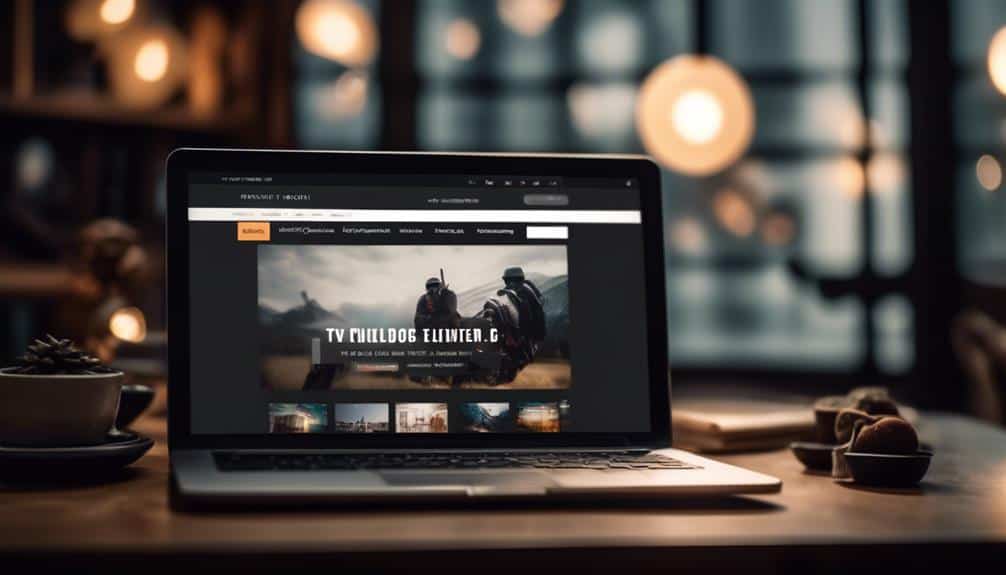User Experience and SEO: How to Design a Blog That Search Engines Love
Imagine your blog as a stylish boutique tucked away in a bustling city. Just like how passersby are drawn to well-decorated storefronts, search engines are attracted to websites that offer a seamless user experience.
From navigating the aisles effortlessly to finding the perfect item with ease, creating a blog that balances user experience and SEO is crucial for standing out in the digital landscape. But how can you ensure your blog is not only visually appealing but also optimized to catch the eye of search engines?
Let's uncover the key strategies that will help you elevate your blog's performance and visibility in the vast online marketplace.
Key Takeaways
- Implement mobile-first design strategies to enhance user experience and improve SEO performance.
- Regularly update content to maintain relevance, attract visitors, and boost search rankings.
- Optimize meta tags and descriptions to improve click-through rates and increase organic traffic.
- Utilize speed optimization techniques like image compression and content delivery networks to enhance site performance and user satisfaction.
Understanding UX and SEO

To enhance your website's performance in search engine results and provide a seamless user experience, understanding the interplay between UX and SEO is crucial. Conversion rate and user engagement are two key elements affected by this relationship. By optimizing your site for search engines, you can attract more visitors, but it's equally important to keep them engaged once they arrive.
Improving user engagement involves creating a website that's easy to navigate, visually appealing, and provides valuable content. Search engines like Google consider user engagement metrics, such as bounce rate and time on page, when determining search rankings. Therefore, a well-designed user experience not only pleases visitors but also boosts your SEO efforts.
Moreover, a positive user experience often leads to higher conversion rates. When visitors find your site easy to use and the content relevant, they're more likely to take the desired action, whether it's making a purchase, signing up for a newsletter, or filling out a contact form. By focusing on both UX and SEO, you can create a successful website that attracts, engages, and converts visitors effectively.
Importance of Mobile Optimization
Mobile optimization is crucial for maximizing your website's reach and performance in today's digital landscape. With the majority of users accessing content on their mobile devices, ensuring a seamless mobile experience is key to success. Adopting a mobile-first approach, where you prioritize designing for mobile devices before desktops, is a strategic move that enhances user experience and boosts SEO.
Implementing responsive design allows your website to adapt to different screen sizes, providing a consistent experience across devices. Additionally, integrating Accelerated Mobile Pages (AMP) can significantly improve page load times on mobile, enhancing both user experience and search engine rankings.
To highlight the importance of mobile optimization further, take a look at the following table comparing a non-optimized website versus one that has been optimized for mobile:
| Non-Optimized Website | Optimized Website | |
|---|---|---|
| Page Load Speed | Slow | Fast |
| Mobile Traffic | Low | High |
| Bounce Rate | High | Low |
| User Engagement | Decreased | Increased |
| Search Engine Rankings | Lower | Higher |
Content Relevance and Quality

Enhancing content relevance and quality is paramount for optimizing your website's performance and attracting a targeted audience. To achieve this, you must delve into keyword research to understand what your audience is searching for and tailor your content strategy accordingly.
- Focus on Long-Tail Keywords: Long-tail keywords are specific phrases that attract highly targeted traffic.
- Create High-Quality Content: Engaging, informative, and well-researched content won't only attract users but also improve your search engine rankings.
- Update and Refresh Content: Regularly updating and refreshing your content keeps it relevant and signals to search engines that your website is active.
- Optimize Meta Tags and Descriptions: Crafting compelling meta tags and descriptions using relevant keywords can improve click-through rates.
- Monitor and Analyze Performance: Use analytics tools to track the performance of your content and make data-driven decisions to enhance its relevance and quality.
Site Speed and Performance
To boost your blog's performance and enhance user experience, implementing speed optimization techniques is crucial.
Utilize performance monitoring tools to track your site's loading times and identify areas for improvement.
Speed Optimization Techniques
Implementing effective speed optimization techniques is crucial for boosting both search engine rankings and user satisfaction on your blog. To enhance your site's performance, consider the following strategies:
- Browser Caching: Utilize browser caching to store frequently accessed resources on visitors' devices, reducing loading times.
- Image Compression: Optimize images to reduce file sizes without compromising quality, speeding up page loading.
- Minify CSS and JavaScript: Remove unnecessary characters and spaces in code to decrease file sizes and improve load times.
- Content Delivery Networks (CDNs): Distribute your content across multiple servers worldwide to reduce latency and accelerate content delivery.
- Reduce Server Response Time: Enhance server performance by optimizing databases, using efficient coding practices, and employing caching mechanisms.
Performance Monitoring Tools
By monitoring your blog's site speed and performance using specialized tools, you can track the effectiveness of the speed optimization techniques you've implemented. Performance tracking and data analytics are crucial for ensuring your blog is meeting user expectations and search engine requirements. Utilizing tools like Google's PageSpeed Insights, GTmetrix, or Pingdom can provide you with valuable insights into your blog's loading times, server response times, and overall performance metrics. These tools offer detailed reports and suggestions for improvement, allowing you to make data-driven decisions to enhance your site's speed and user experience. Regularly monitoring and analyzing these performance metrics will help you stay ahead in the competitive online space, driving better engagement and ultimately improving your blog's SEO performance.
| Performance Monitoring Tools | Key Features | Benefits |
|---|---|---|
| Google's PageSpeed Insights | Provides performance score | Offers optimization suggestions |
| GTmetrix | Page load time monitoring | Detailed waterfall analysis |
| Pingdom | Real-time performance alerts | Performance trend tracking |
Optimizing Meta Tags

Enhancing your meta tags is a critical step in boosting your blog's visibility and attracting more organic traffic. Optimizing these tags can significantly impact your blog's search engine ranking and click-through rates. To make the most of your meta tags, consider the following strategies:
- Strategic Keyword Placement: Incorporate relevant keywords naturally within your meta tags to signal search engines about your content's focus.
- Compelling Meta Descriptions: Craft engaging meta descriptions that not only include keywords but also entice users to click through to your blog.
- Unique Meta Titles: Create unique and descriptive meta titles that accurately represent the content on your blog post.
- Mobile Optimization: Ensure that your meta tags are optimized for mobile devices to cater to the increasing number of mobile users.
- Regular Updates: Keep your meta tags up-to-date with the latest keyword trends and changes in your blog content to maintain relevance.
When it comes to user-friendly navigation, remember that a clear menu structure can significantly enhance the browsing experience for visitors.
An intuitive search function ensures that users can easily find what they're looking for, boosting engagement and satisfaction.
Additionally, optimizing your blog for mobile devices is crucial in today's digital landscape to cater to users on the go.
Clear Menu Structure
To ensure a seamless user experience on your blog, prioritize organizing your menu structure with clear and intuitive navigation options. A well-structured menu not only enhances user experience but also boosts SEO optimization.
Here are five key points to consider when designing your menu:
- Keep it Simple: Avoid overcrowding your menu with too many options.
- Use Descriptive Labels: Ensure that menu items clearly represent the content they lead to.
- Prioritize Important Pages: Place crucial pages like 'About' or 'Contact' prominently.
- Implement Dropdown Menus: Organize subcategories under main menu items for easy navigation.
- Mobile Responsiveness: Ensure your menu is mobile-friendly for users on the go.
Intuitive Search Function
Incorporate a streamlined search function on your blog to enhance user navigation and accessibility. By integrating voice search capabilities and analyzing user behavior, you can create a seamless search experience. Utilize semantic search techniques and conduct thorough keyword research to ensure the search function understands user intent accurately. Here's a table highlighting the key elements for an intuitive search function:
| Key Elements | Description | Importance |
|---|---|---|
| Voice Search Integration | Enable users to search using voice commands | High |
| User Behavior Analysis | Understand how users search and interact with results | Medium |
| Semantic Search | Enhance search accuracy by understanding context | High |
| Keyword Research | Identify relevant keywords for better search results | High |
| Mobile Optimization | Ensure search function works seamlessly on mobile devices | Medium |
Mobile-Friendly Design
Enhance user experience by optimizing your blog's design for mobile devices with intuitive navigation that prioritizes ease of use. In today's digital landscape, responsive design is crucial for engaging users on various devices.
To ensure your blog is mobile-friendly and promotes user engagement, consider the following:
- Implement a responsive design that adapts seamlessly to different screen sizes.
- Simplify navigation by using clear menus and intuitive icons for easy access to content.
- Prioritize speed by optimizing images and minimizing unnecessary elements for quicker load times.
- Incorporate touch-friendly elements like larger buttons and clickable areas to enhance user interaction.
- Test your blog on different mobile devices to ensure a consistent and user-friendly experience across platforms.
Image and Video Optimization
Optimizing images and videos is essential for boosting your blog's visibility and enhancing user engagement. When it comes to images, using image compression techniques is crucial to ensure fast loading times, which positively impacts SEO ranking and user experience. Additionally, providing image alt text helps search engines understand the content of your images, further boosting your blog's discoverability. For videos, incorporating captions not only improves accessibility for users with hearing impairments but also provides search engines with more context about your video content, potentially increasing its relevance in search results.
To illustrate the importance of image and video optimization, consider the following table:
| Optimization Technique | Benefits |
|---|---|
| Image Compression | Faster loading times, improved SEO ranking |
| Alt Text for Images | Enhanced discoverability by search engines |
| Video Captions | Better accessibility, increased content relevance |
Internal Linking Strategy

After ensuring optimal visibility and user engagement through image and video optimization, the next step is to strategically implement an effective internal linking strategy to further enhance your blog's performance and accessibility.
When it comes to internal linking, consider the following key tactics to boost your blog's SEO and user experience:
- Anchor Text Optimization: Use descriptive anchor text that includes relevant keywords to improve the context and relevance of your internal links.
- Distribute Link Juice: By strategically linking to pages with lower page authority from high-authority pages, you can pass on link juice and improve the visibility of your entire website.
- Create a Logical Structure: Organize internal links in a logical manner that helps users navigate your blog easily and search engines understand the hierarchy of your content.
- Avoid Over-Optimization: While internal linking is essential, avoid excessive linking as it can appear spammy to both users and search engines.
- Monitor and Adapt: Regularly review your internal linking strategy, analyze performance metrics, and make adjustments to optimize your blog's effectiveness.
Utilizing Structured Data
To elevate your blog's performance and enhance its visibility, harness the power of structured data to provide search engines with valuable information about your content. By implementing Schema markup, you can significantly impact your rankings and visibility on search engine results pages. Rich snippets, which are enhanced search results displayed with extra information, like star ratings or images, can make your blog stand out and attract more clicks. Here's a glimpse of how structured data can benefit your blog:
| Benefit | Description |
|---|---|
| Improved Rankings | Schema markup helps search engines understand your content and its context. |
| Enhanced Visibility | Rich snippets make your blog more visually appealing in search results. |
| Better CTR | Rich snippets can increase your Click-Through Rate (CTR) by providing more information upfront. |
| Increased Traffic | When searchers see additional details in your snippet, they are more likely to click through to your site. |
Incorporating structured data is a strategic move that can give your blog a competitive edge and drive more traffic to your content.
Monitoring and Analyzing Metrics
You should focus on tracking user behavior, analyzing traffic sources, and improving site performance.
By monitoring these key metrics, you can gain valuable insights into how users interact with your blog and where your traffic is coming from.
This data-driven approach will help you optimize your blog for both search engines and user experience.
Tracking User Behavior
Optimizing your blog's performance through meticulous tracking and analysis of user behavior metrics is crucial for enhancing both SEO and user experience. To achieve this, consider the following:
- Utilize Click heatmap: Visualize where users are clicking the most on your blog.
- Conduct Interaction Analysis: Understand how users engage with your content.
- Track Bounce Rates: Monitor the percentage of visitors who navigate away from your site after viewing only one page.
- Analyze Dwell Time: Measure how long users spend on your blog posts.
- Study Conversion Rates: Evaluate the rate at which visitors complete a desired action on your blog.
Analyzing Traffic Sources
Enhancing your blog's performance through meticulous tracking and analysis of user behavior metrics naturally leads to a focus on Analyzing Traffic Sources, a critical aspect of optimizing for SEO and user experience. By delving into Referral traffic analysis, you can uncover valuable insights into which external sites are driving visitors to your blog. Understanding Organic search insights helps you refine your content to attract more organic traffic from search engines. Monitoring Social media engagement enables you to gauge the impact of your social media efforts on blog traffic. Analyzing Direct traffic patterns allows you to see how users are directly accessing your blog, providing insights into the effectiveness of your branding and direct outreach strategies.
| Traffic Source | Key Insights |
|---|---|
| Referral Traffic | Identify external sources driving traffic. |
| Organic Search | Understand search engine impact on traffic. |
| Social Media Engagement | Evaluate social media impact on blog visits. |
| Direct Traffic Patterns | Assess effectiveness of direct outreach strategies. |
Improving Site Performance
Improving Site Performance involves constant monitoring and analysis of key metrics to ensure optimal functionality and user satisfaction. To enhance your blog's performance, consider the following strategies:
- Implement Load Time Optimization: Streamline your website's code and assets to reduce loading times.
- Focus on UX/UI Design: Create intuitive layouts and navigation to improve user experience.
- Utilize Caching Strategies: Cache static content to speed up page loading for returning visitors.
- Conduct Performance Testing: Regularly test your site's speed and responsiveness to identify areas for improvement.
- Analyze Metrics Continuously: Use tools like Google Analytics to track performance metrics and make data-driven decisions.
Frequently Asked Questions
How Can I Improve My Blog's Visibility in Search Engine Results Pages?
To boost your blog's visibility in search engine results pages, start with thorough keyword research and a solid content strategy. Ensure mobile optimization and improve site speed for a competitive edge in search rankings.
What Are Some Common Mistakes to Avoid When Optimizing for User Experience and Seo?
To optimize for better user experience and SEO, avoid these common pitfalls: slow page speed, lack of mobile optimization, keyword stuffing, and poor navigation. Embrace UX best practices like clear headings, engaging content, and intuitive design.
How Can I Effectively Measure the Success of My Blog's SEO Efforts?
To effectively measure your blog's SEO success, start with conversion tracking and analytics. Dive into keyword research and competitor analysis for insights. Use data-driven strategies to optimize your content and boost your blog's performance.
What Role Does Social Media Play in Improving SEO for a Blog?
To boost SEO for your blog, social media engagement is crucial. Conduct keyword research to target your audience effectively. Backlink building and content promotion through social platforms amplify your blog's visibility and ranking potential.
How Can I Stay Updated on the Latest Trends and Best Practices in UX and SEO for Blogging?
To stay updated on the latest trends and best practices in UX and SEO for blogging, engage with industry insights and community discussions. Attend networking events and enroll in online courses to enhance your knowledge and skills.
Conclusion
In conclusion, combining user experience and SEO is essential for creating a blog that search engines love.
By focusing on mobile optimization, content quality, site speed, meta tags, media optimization, internal linking, structured data, and monitoring metrics, you can improve your blog's visibility and engagement.
Remember, a well-designed blog that prioritizes user satisfaction won't only attract search engines but also keep readers coming back for more.
Keep optimizing and analyzing to stay ahead in the digital landscape.








